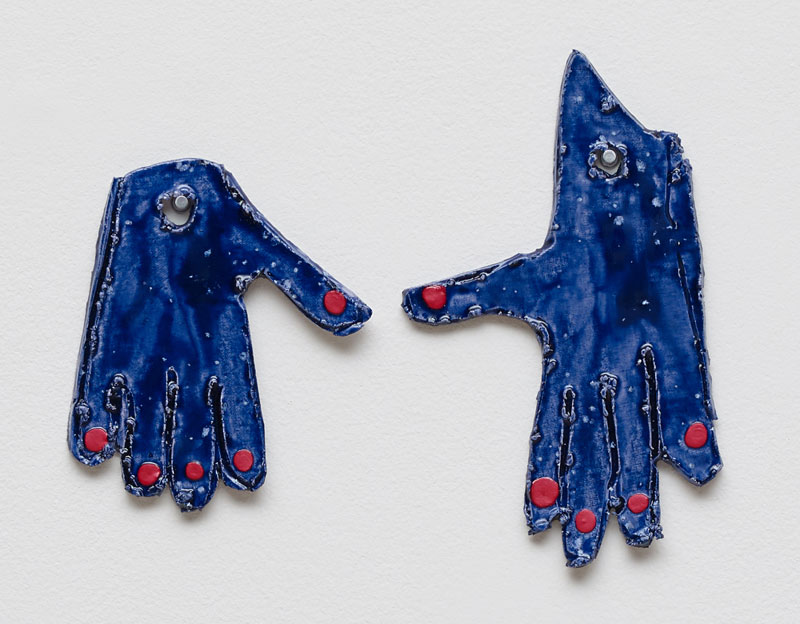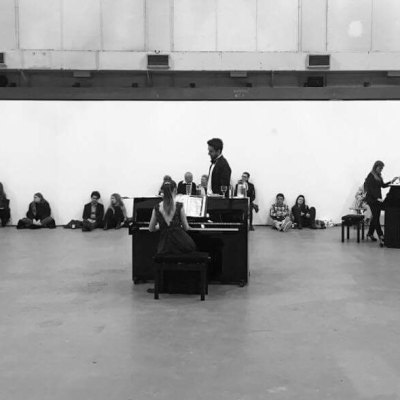Polly Apfelbaum’s ‘Dubuffet’s Feet My Hands’ shows two new bodies of work alongside each other – and bodies, it seems, are the name of the game. Hands hang from the walls of Frith Street Gallery, and enormous woven outlines of footprints decorate the floor on four rugs. Although Apfelbaum has been placing works on gallery floors since the beginning of her career in the 1970s, her first actual rug work was made in 1997, and it wasn’t until her residency with the American Academy of Rome in 2012/13 that carpets came to dominate her oeuvre in earnest.
For Apfelbaum, the bounteous cultural history of Rome and its art came to represent a new vista. As she explains to me, on my visit to her show: ‘I came late in my career, but it was just what the doctor ordered. To slow down, take your time… [At the academy] there are composers, architects, classicists, and it’s about conversation.’ Conversation feels an apt framework through which to consider Apfelbaum’s newest works. These constitute something of a palimpsest: source upon source, and traditions in dialogue, coalescing.
‘Polly Apfelbaum: Dubuffet’s Feet My Hands’, installation view at Golden Square, Frith Street Gallery, London. Image © Polly Apfelbaum and Frith Street Gallery, London.

The rugs were hand-woven in collaboration with artisans in Oaxaca, Mexico, while their design is pulled from Jean Dubuffet’s sketch from 1948, ‘Footprints in the sand’. Apfelbaum has lifted Dubuffet’s doodle from the page and placed it gently on the ground. One foot marks each rug, two left and two right, scaled up so that, if they were ‘real’, the prints would be made by a being more than 100 feet tall. ‘It’s like Gulliver’s Travels,’ Apfelbaum jokes. The giant outlines sit on sandy earth tones. When they arrived at the gallery, she tells me, ‘I felt almost that I’d excavated them. Like I’d found the feet there, like fossils – and in Rome, we were always going down. You put together the pieces, all these associations rise to the top, and it’s so unexpected.’
These monstrous feet are shown alongside ‘My Hands’, 97 ceramic pairs based on Apfelbaum’s own. They hang on the gallery walls between two bands of colour: terracotta red and earthy green, alluding to their clay medium. Traced crudely in two dimensions before glazing and firing, the hands are a deliberate reference to the floating ‘hand of god’, which Apfelbaum encountered in Ravenna’s mosaics during her residency. The hand of the artist has the power to create and intervene much like a deity’s; Apfelbaum’s, though, are couched squarely in the realm of the human. ‘The hands are small, and they’re my hands. Dubuffet, he’s mythic. He’s my imagination.’
My Hands (2017), Polly Apfelbaum. Image © Polly Apfelbaum and Frith Street Gallery, London.

Apfelbaum continues: ‘The hand – for me – was about bringing myself back into the picture. The thing with ceramics, with weaving, is that it’s so basic. Those crafts have history too, besides the religion element. I’m not a luddite, but all of that is operating in my work. The process is a very important thing – the time in the studio, weaving time, baking time…’ Craft is a female type of labour, too, I suggest: without glory, time-consuming, essential. And rugs, ceramics – these are materials we’re less accustomed to seeing in galleries than in domestic spaces. For millennia, these have been the female sphere. And then we really get cooking. ‘That’s what got me to the floor,’ explains Apfelbaum. ‘I didn’t want to be up on the pedestal – that was a man’s world. I wanted to be in a different space. I wanted to open it up materially, open it up conceptually.’ Simply put, she has established the different space she sought. And yet, ‘feminism is just another colour in the work. It’s so ingrained, it’s so innate, that sometimes I don’t even talk about it – it’s so there.’
Much like Apfelbaum’s description of feminism as another colour in her palette, so disparate ideologies – religion, the canon – are deployed with a lightness of touch which makes them feel organic. We’re not always conscious of our influences. When discussing ceramic as material (as in My Hands), Apfelbaum relishes the possibility for ‘accidents’. Human beings are made of accidents, by accidents; the accidental becomes embedded in tradition and thought of as anything but happenstance. ‘Culture is insidious. The gender thing is insidious. If I were to put a man’s name on the show, or use P. Apfelbaum… there are things you walk into culturally, and it’s a set up. How do you navigate that?’ she continues. Apfelbaum, for one, seems to have found a path: pulling the work of myriad artists, each heavy with their own inheritance, into one.
I ask Apfelbaum about the exhibition’s title: ‘Dubuffet’s Feet My Hands’. Idiomatically, we tend to list hands before feet – don’t we? Her reply: ‘I went feet first – ha! – but then I thought, what about my hands? What about me?’ While Apfelbaum’s rugs came chronologically before her hand sculptures, just as Dubuffet’s work preceded her own, both were birthed by the latter. Their juxtaposition enacts a surprising harmony: a gentle and righteous appropriation of the canon alongside the manifest immediacy of human bodies.
‘Polly Apfelbaum: Dubuffet’s Feet My Hands’, is at Frith Street Gallery, London, until 2 February 2018.



